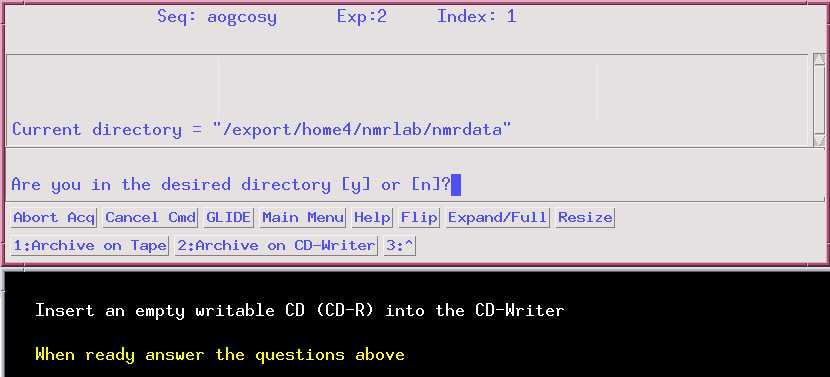
Writing Data to a CD-Writer (updated 2004-07-19)
If you are interested in how to retrieve data from a CD (i.e. after the "burning" process) click here.
The operation of the CD-Writer is not difficult. However, as you are archiving potentially very important data (your data!), you should be sure that you really know what you are doing.
This short tutorial gives you a chance to see beforehand what to expect. Most
importantly, there is only one way to be absolutely sure that the CD is what you would
like it to be. After the completion of the writing process,
check if you can read a few files from inside
VNMR. It is not enough to see the directory: this is written first and separate
from the actual data.
Much better is to load and process two or three different files:
for example one from the beginning, one from the middle and one from the end of
the directory. If they work, then you have a very
high degree of certainty that all the others work,
too.
This should not be misunderstood as CD-burning being
unreliable - it is just good to be
absolutely sure when it comes to data archiving.
As of July 2004, we have CD-burning capabilities on three systems: the data stations d601 (SB-3G) , d500 (WB-13) and ibdw (EB-44). All three use a CD-burner/reader (52x/32x/52x) combination drive which means that the same device can also read the data (this was not possible with the older UNIX/Solaris operating system prior to 2004-07). Note that multi-session CD-burning is not supported. All spectrometers provide CD-ROMs only (no disk burning is available, nor is it planned for the foreseeable future).
The user nmrlab is used in this example. After logging in, VNMR shows the main menu. From here it takes three clicks to use the CD-Writer:



This is the data archive menu level.
You can
choose between archiving on the DDS-2 tape or the CD-Writer
(no longer supported).
After selecting
the CD-Writer option you see the following window:

This is the moment to change to another directory
if necessary. In this case n
would definitely be the right answer as the .../nmrdata directory is
typically too
large for a CD because it holds the data of all users
in the same account, and is therefore not
useful for one individual. An input of n gets
you to the usual menu level to
navigate to other directories:

In this example, a change to a subdirectory called paul was made and the subsequent question about the correct directory was answered with y as seen below. If you are in the desired directory then a y will request some checks by the system and creates the following information:

The appearance of the question whether to continue or not indicates that your request passed two different checks. If, as in this example, only slightly more than 10% of the CD's capacity is going to be used, you may want to wait for more data. But the decision is entirely up to you.
If you answer y, you will be asked one more question: whether or not you want a printout of the file and directory names of the CD that is about to be created. If you answer with y, you will get the printout AFTER the CD burning process is finished to eliminate potential problems discussed in NMR News 2001-04 and 2001-05. If you don't want the printout, simply enter n.
A y to the printout question will produce the output shown below and start the writing ("burning") process (n gives a slightly different response). There is no stopping the CD-burning until complete. What happens while working in the background is listed.

The printout, if chosen as an option, of the CD's contents has the following format (the numbers do not match the ones used in the example above).
| Tue Jul 20 15:23:21 MST 2004 | exact date and time |
| d601 | computer which created the CD |
| /export/home4/nmrlab/nmrdata/paul | the directory with full path name |
| 111 | ./penta_1D_d2o_27C_601.fid | list of files (directories) including their size that are part of this CD |
| 22603 | ./penta_hmqc_d2o_27C_601.fid | |
| 6971 | ./penta_hmqcdec_d2o_27C_601.fid | |
| 1044 | ./penta_hmqcsemisoft_d2o_27C_601.fid |
|
| 30729 | grand total in Kbytes |
| CDfile-2004.07.20-15:23:21 | name of the CDfile with date/time stamp |
The CD will be ejected automatically when burning is complete.
Automatic checks by the system prior to CD-writing:
|
|
the size of the data is checked: if it is over 635 MB the
process is aborted: Content of the chosen directory is xyz Mbyte - max. is 635 Mbyte |
|
|
if the directory is a CD in the CD-ROM
drive, the process is terminated with an error message: |
The reasons for the first test
is obvious: a CD ends up as a "coaster" if an attempt is made to write
over its capacity. This check prevents this from happening
and factors in space needed for the directory.
The second test
is a direct consequence
that the same device is used for writing and reading - cannot do
both at the same time. The text of the error message is still from the times
when burning and writing was done with different devices but the transfer was
too slow. Whatever the message, it still cannot be done.